Related Research Articles

A blizzard is a severe snowstorm characterized by strong sustained winds and low visibility, lasting for a prolonged period of time—typically at least three or four hours. A ground blizzard is a weather condition where snow is not falling but loose snow on the ground is lifted and blown by strong winds. Blizzards can have an immense size and usually stretch to hundreds or thousands of kilometres.
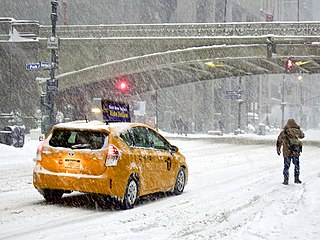
A winter storm is an event in which wind coincides with varieties of precipitation that only occur at freezing temperatures, such as snow, mixed snow and rain, or freezing rain. In temperate continental climates, these storms are not necessarily restricted to the winter season, but may occur in the late autumn and early spring as well. A snowstorm with strong winds and other conditions meeting certain criteria is called a blizzard.

The Northeastern United States blizzard of 1978 was a catastrophic, historic nor'easter that struck New England, New Jersey, Pennsylvania and the New York metropolitan area. The Blizzard of '78 formed on Sunday, February 5, 1978, and broke up on February 7. The storm was primarily known as "Storm Larry" in Connecticut, following the local convention promoted by the Travelers Weather Service on television and radio stations there. Snow fell mostly from Monday morning, February 6, to the evening of Tuesday, February 7. Connecticut, Rhode Island, and Massachusetts were hit especially hard by this storm.

The Great Blizzard of 1888, also known as the Great Blizzard of '88 or the Great White Hurricane, was one of the most severe recorded blizzards in American history. The storm paralyzed the East Coast from the Chesapeake Bay to Maine, as well as the Atlantic provinces of Canada. Snow fell from 10 to 58 inches in parts of New Jersey, New York, Massachusetts, Rhode Island, and Connecticut, and sustained winds of more than 45 miles per hour (72 km/h) produced snowdrifts in excess of 50 feet (15 m). Railroads were shut down and people were confined to their homes for up to a week. Railway and telegraph lines were disabled, and this provided the impetus to move these pieces of infrastructure underground. Emergency services were also affected.

The North American blizzard of 1996 was a severe nor'easter that paralyzed the United States East Coast with up to 4 feet (1.2 m) of wind-driven snow from January 6 to January 8, 1996. This storm was a classic example of a nor'easter, but the storm would not have been as historically significant without the presence of the arctic high pressure system located to the north of New York. It was followed by another storm, an Alberta Clipper, on January 12, then unusually warm weather and torrential rain which caused rapid melting and river flooding. Along with the March Superstorm of 1993 and the January 2016 United States blizzard, it is one of only three snowstorms to receive the top rating of 5, or "Extreme", on the Northeast Snowfall Impact Scale (NESIS).

The North American blizzard of 2006 was a nor'easter that began on the evening of February 11, 2006. It dumped heavy snow across the Mid-Atlantic and New England states, from Virginia to Maine through the early evening of February 12, and ended in Atlantic Canada on February 13. The major cities from Baltimore to Boston received at least a foot of snow, with a second-highest amount of 26.9 inches (68.3 cm) in New York City, the most since at least 1869, the start of record keeping, only broken by the January 2016 United States blizzard nearly 10 years later.

The 1804 New England hurricane was the first tropical cyclone in recorded history known to have produced snowfall. An unusual late-season storm in 1804, it yielded vast amounts of snow, rain, and powerful winds across the northeastern United States. Prior to its approach towards the East Coast of the United States, it passed through the Caribbean Sea on October 4, and later emerged near Georgetown, South Carolina. By early on October 9, a trough near the Virginia Capes turned the disturbance toward New England. Soon thereafter, the hurricane's abundant moisture clashed with an influx of cold Canadian air, leading to the deepening of the resulting pressure gradient and provoking inland intensification. While situated over Massachusetts, it attained its peak intensity of 110 mph (175 km/h), undergoing an extratropical transition. Even as it drifted towards the Canadian maritimes, consequently gradually weakening, precipitation persisted for another two days before the snowstorm finally subsided on October 11.
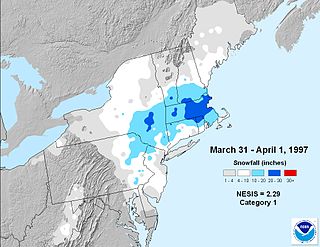
The 1997 April Fool's Day blizzard was a major winter storm in the Northeastern United States on March 31 and April 1, 1997. The storm dumped rain, sleet, and snow from Maryland to Maine leaving hundreds of thousands without power and as much as three feet of snow on the ground.

The Blizzard of January 1881 was one of the most severe blizzards ever to hit the southern parts of the United Kingdom.
The North American blizzard of 1947 was a record-breaking snowfall that began without prediction on Christmas and brought the northeastern United States to a standstill. The snowstorm was described as the worst blizzard in the region after that of 1888. The storm was not accompanied by high winds, but the snow fell silently and steadily. By the time it stopped on December 26, accumulation had reached 26.4 inches in Central Park in Manhattan. Similar or greater accumulations were noted in all of metropolitan New York and New Jersey, as well as in upstate New York, Connecticut, and most of the mid-Atlantic region.
The East Asian snowstorms of 2009–2010 were heavy winter storms, including blizzards, ice storms, and other winter events, that affected East Asia from 8 May 2009 to 28 February 2010. The areas affected included Mongolia, China, Nepal, the Korean Peninsula, Japan, Kuril Islands, Sea of Okhotsk, Primorsky, and Sakhalin Island.

The December 1960 nor'easter was a significant early-season winter storm that impacted the Mid-Atlantic and New England regions of the United States. Moderate to heavy snowfall fell from West Virginia to eastern Maine, amounting to 10 in (25 cm) or more in parts of 13 states and peaking at 21.4 in (54.4 cm) at Newark, New Jersey. The storm was accompanied by strong winds, gusting to over 90 mph (145 km/h) in coastal New England, and left in its wake a dangerously cold air mass. The storm originated in a weak low pressure area which formed over the western Gulf of Mexico on December 10. A secondary low developed over South Carolina on the next day, supported by the merger of two troughs aloft. Sliding southeast of New England, the new storm explosively deepened to become a full-fledged nor'easter, with a minimum central air pressure of 966 mbar. It began to weaken over the Canadian Maritimes.
Global weather activity of 2009 profiles the major worldwide storms, including blizzards, tornadoes, ice storms, tropical cyclones and other meteorogical events, from January 1, 2009, to December 31, 2009. Wintery storms are events in which the dominant varieties of precipitation are forms that only occur at cold temperatures, such as snow or sleet, or a rainstorm where ground temperatures are cold enough to allow ice to form. It may be marked by strong wind, thunder and lightning, heavy precipitation, such as ice, or wind transporting some substance through the atmosphere. Summer storms including flooding, severe thunderstorms and extratropical cyclones are also included in this list to a certain extent.

The February 2013 North American blizzard, also known as Winter Storm Nemo and the Blizzard of 2013, was a powerful blizzard that developed from the combination of two areas of low pressure, primarily affecting the Northeastern United States and parts of Canada, causing heavy snowfall and hurricane-force winds. The storm crossed the Atlantic Ocean, affecting Ireland and the United Kingdom. The nor'easter's effects in the United States received a Category 3 rank on the Northeast Snowfall Impact Scale, classifying it as a "Major" Winter Storm.

Winter storm naming in the United States has been used sporadically since the mid-1700s in various ways to describe historical winter storms. These names have been coined using schemes such as the days of the year that the storm impacted or noteworthy structures that the storm had damaged and/or destroyed. In the 2010s, winter storm naming became controversial with The Weather Channel coming up with its own list of names for winter storms similar to that of hurricanes. The marketing of weather became a big part of media revenue by the 1990s. Various other media outlets soon followed The Weather Channel with their own naming lists. Most government and research meteorologists argue that winter storms can reform more than once, making the process of naming them both difficult and redundant. Entities from the United States government, including the National Oceanic and Atmospheric Administration (NOAA) and the National Weather Service (NWS), have stated that they would not be naming winter storms, and have asked others to refrain from doing so.

The January 31 – February 2, 2015 North American blizzard was a major winter storm that plowed through the majority of the United States, dumping as much as 2 feet (24 in) of new snowfall across a path from Iowa to New England, as well as blizzard conditions in early February 2015. It came less than a week after another crippling blizzard which impacted the Northeast with 2–3 feet of snow. It was the first of many intense winter storms to occur in the nation during the month of February, partly in due to an ongoing cold wave that was beginning to take shape shortly after the storm subsided.
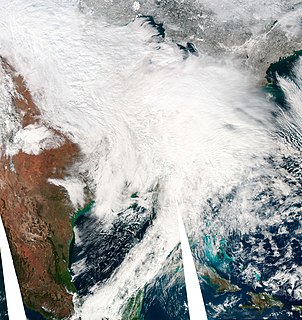
The 2009–10 North American winter saw several major blizzards affect the Northeastern United States. It refers to winter as it occurred across the North American continent from late 2009 to early 2010. While there is no well-agreed-upon date used to indicate the start of winter in the Northern Hemisphere, there are two definitions of winter which may be used. Based on the astronomical definition, winter begins at the winter solstice, which in 2009 occurred on December 21, and ends at the March equinox, which in 2010 occurred on March 20. Based on the meteorological definition, the first day of winter is December 1 and the last day February 28. Both definitions involve a period of approximately three months, with some variability.
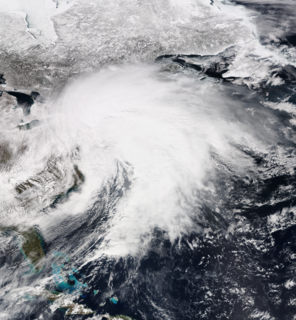
The March 2017 North American blizzard was a major late-season blizzard that affected the Northeastern United States, New England and Canada, dumping up to 3 feet of snow in the hardest hit areas, mainly New York, Vermont, New Hampshire and Southern Quebec. Forming out of an extratropical cyclone near the Northwest, the storm system dived into the northern portions of the United States, dropping light to moderate snow across the Great Lakes, Upper Midwest on March 11–12 before reaching the Ohio Valley the next day. It later coalesced into a powerful nor'easter off the East Coast, producing a swath of heavy snowfall across a large portion of the Northeast. The storm was given various unofficial names, such as Winter Storm Stella, Blizzard Eugene, and Blizzard of 2017.
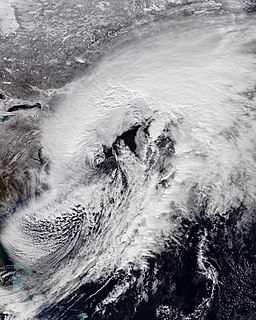
The January 2022 North American blizzard caused widespread and disruptive impacts to the Atlantic coast of North America from Delaware to Nova Scotia with as much as 2.5 feet (30 in) of snowfall, blizzard conditions and coastal flooding at the end of January 2022. Forming from the energy of a strong mid- to upper-level trough, the system developed into a low-pressure area off the Southeast United States on January 28. The system then quickly intensified that night as it traveled northeastly parallel to the coast on January 29, bringing heavy snowfall blown by high winds to the East Coast of the continent. Further north, it also moved inland in Maine and its width meant it strongly impacted all three of Canada's Maritime provinces. In some areas, mainly the coastal regions of New Jersey, Long Island and Massachusetts, it was the first blizzard since a storm in January 2018. The storm was considered a "bomb cyclone" as it rapidly intensified and barometric pressure dropped at least 24 millibars over a 24-hour period. The storm was given names such as Blizzard of 2022 and Winter Storm Kenan.

The Great Snowstorm of 1944 was a distruptive winter storm that brought high winds and between 12 and 30 inches of snow to the eastern Great Lakes region of North America between Sunday, December 10, and Wednesday, December 13, 1944. The areas most affected included northeastern Ohio, western Pennsylvania, West Virginia, upstate New York, southern Ontario and southern Quebec.
References
- ↑ The Big One! A Review of the March 12-14, 1993 "Storm of the Century" (PDF) Accessed 2009-02-03.
- 1 2 3 4 Zielinski and Keim, pg. 181
- 1 2 3 Cram, William Dow (1938-12-01). "The Great Blizzard of 1717". Little Stories of Old New England. Hampton Union and Rockingham County Gazette. Retrieved 2009-02-03.
- 1 2 Perley, pg. 33
- ↑ "The Great Blizzard of 1717 | Lane Memorial Library". www.hampton.lib.nh.us. Retrieved 2022-01-17.
- 1 2 3 Perley, pg. 35
- ↑ Have Snow Shovel, Will Travel Archived 2009-04-28 at the Wayback Machine Accessed 2009-02-03.
- ↑ Burt and Stroud, pg. 90
- ↑ Perley, pg. 34
- ↑ "Remembering the Great Snow of 1717 in New England". New England Historical Society. 27 February 2014. Retrieved 13 February 2015.
Book references
- Burt, Christopher C.; Stroud, Mark (2004). Extreme Weather: A Guide & Record Book. W. W. Norton & Company. ISBN 0-393-32658-6.
- Perley, Sidney (1891). "The Winter of 1716–1717". Historic Storms of New England (PDF). Salem, Massachusetts: The Salem Press Publishing and Printing Company. Book ID #3 3433 06908250 5. Retrieved 2009-02-03.
- Thoreau, Henry D. (1894). Walden. Ticknor and Fields: Boston. ISBN 978-8525420602
- Zielinski, Gregory A.; Keim, Barry D. (2003). New England Weather, New England Climate. Hanover and London: University Press of New England. ISBN 1-58465-312-4.